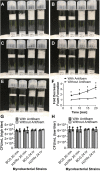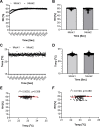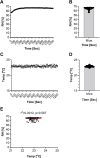Targeted dose delivery of Mycobacterium tuberculosis in mice using silicon antifoaming agent via aerosol exposure system
- PMID: 36228009
- PMCID: PMC9560519
- DOI: 10.1371/journal.pone.0276130
Targeted dose delivery of Mycobacterium tuberculosis in mice using silicon antifoaming agent via aerosol exposure system
Abstract
Mycobacterium tuberculosis (Mtb) is an intracellular pathogen that forms aggregates (clumps) on solid agar plates and in liquid media. Detergents such as Tween 80/Tyloxapol are considered the gold standard to disrupt clump formation in Mtb cultures. The presence of detergent, however, may generate foam and hinder Mtb aerosolization thus requiring addition of an antifoam agent for optimal Mtb aerosol-based procedures. Aerosol inhalation can be technically challenging, in particular to achieve a reproducible inhaled target dose. In this study, the impact of an antifoam, the silicon antifoaming agent (SAF), on Mtb aerosolization and whole-body mouse aerosol infection was investigated. A comparative study using SAF in a liquid suspension containing Mycobacterium bovis BCG (M. bovis BCG) or Mtb H37Rv did not cause any adverse effect on bacterial viability. Incorporation of SAF during mycobacteria inhalation procedures revealed that aerosolized mycobacterial strains were maintained under controlled environmental conditions such as humidity, temperature, pressure, and airflow inside the aerosol chamber. In addition, environmental factors and spray factors were not affected by the presence of SAF in mycobacterial cultures during aerosolization. Spray factor was significantly less during aerosol procedures with a low-input dose of mycobacteria in comparison to high-dose, as predicted. The mycobacterial load recovered in the biosampler (AGI) was ~2-3 logs lower than nebulizer or input bacterial load. A consistent Mtb bacillary load determined in mouse lungs indicates that SAF does not affect mycobacteria aerosolization during the aerosol generation process. These data confirmed that 1) SAF prevents formation of excessive foam during aerosolization, 2) SAF had no negative impact on mycobacterial viability within aerosol droplets, 3) Mtb droplets within aerosol-generated particles are well within the range required for reaching and depositing deep into lung tissue, and 4) SAF had no negative impact on achieving a target dose in mice exposed to Mtb aerosol.
Conflict of interest statement
The authors have declared that no competing interests exist.
Figures





Similar articles
-
Aerosol immunization by alginate coated mycobacterium (BCG/MIP) particles provide enhanced immune response and protective efficacy than aerosol of plain mycobacterium against M.tb. H37Rv infection in mice.BMC Infect Dis. 2019 Jul 1;19(1):568. doi: 10.1186/s12879-019-4157-2. BMC Infect Dis. 2019. PMID: 31262260 Free PMC article.
-
Natural and trained innate immunity against Mycobacterium tuberculosis.Immunobiology. 2020 May;225(3):151951. doi: 10.1016/j.imbio.2020.151951. Epub 2020 Apr 27. Immunobiology. 2020. PMID: 32423788 Review.
-
The Impact of Genome Region of Difference 4 (RD4) on Mycobacterial Virulence and BCG Efficacy.Front Cell Infect Microbiol. 2017 Jun 8;7:239. doi: 10.3389/fcimb.2017.00239. eCollection 2017. Front Cell Infect Microbiol. 2017. PMID: 28642843 Free PMC article.
-
A New Screen for Tuberculosis Drug Candidates Utilizing a Luciferase-Expressing Recombinant Mycobacterium bovis Bacillus Calmette-Guéren.PLoS One. 2015 Nov 16;10(11):e0141658. doi: 10.1371/journal.pone.0141658. eCollection 2015. PLoS One. 2015. PMID: 26571296 Free PMC article.
-
Is cough really necessary for TB transmission?Tuberculosis (Edinb). 2019 Jul;117:31-35. doi: 10.1016/j.tube.2019.05.003. Epub 2019 May 28. Tuberculosis (Edinb). 2019. PMID: 31378265 Free PMC article. Review.
Cited by
-
Comparative study of a rabbit model of spinal tuberculosis using different concentrations of Mycobacterium tuberculosis.World J Orthop. 2025 Jan 18;16(1):101424. doi: 10.5312/wjo.v16.i1.101424. eCollection 2025 Jan 18. World J Orthop. 2025. PMID: 39850038 Free PMC article.
-
Novel Experimental Mouse Model to Study the Pathogenesis and Therapy of Actinobacillus pleuropneumoniae Infection.Pathogens. 2024 May 15;13(5):412. doi: 10.3390/pathogens13050412. Pathogens. 2024. PMID: 38787263 Free PMC article.
-
Control technologies to prevent aerosol-based disease transmission in animal agriculture production settings: a review of established and emerging approaches.Front Vet Sci. 2023 Nov 14;10:1291312. doi: 10.3389/fvets.2023.1291312. eCollection 2023. Front Vet Sci. 2023. PMID: 38033641 Free PMC article. Review.
-
Structural and Biochemical Characterization of Mycobacterium tuberculosis Zinc SufU-SufS Complex.Biomolecules. 2023 Apr 24;13(5):732. doi: 10.3390/biom13050732. Biomolecules. 2023. PMID: 37238602 Free PMC article.
-
Towards More Precise Targeting of Inhaled Aerosols to Different Areas of the Respiratory System.Pharmaceutics. 2024 Jan 10;16(1):97. doi: 10.3390/pharmaceutics16010097. Pharmaceutics. 2024. PMID: 38258107 Free PMC article. Review.
References
-
- Migliori GB, Bothamley G, Duarte R, Rendon A. Tuberculosis: European Respiratory Society; 2018.
Publication types
MeSH terms
Substances
Grants and funding
LinkOut - more resources
Full Text Sources

